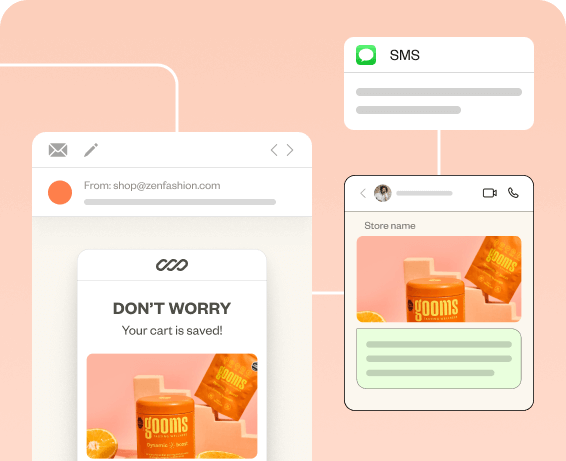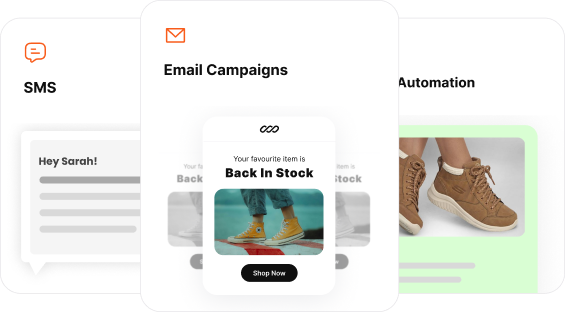Default WordPress email templates may get the job done, but they do nothing for your brand. WordPress emails have one of the highest open rates – 40%, and not customizing them for your brand is a wasted opportunity.
The good news? You don’t have to be a pro in coding to edit WordPress email templates. Sure, a little tech knowledge can help, but it’s not a must.
With the right plugins, you can customize email templates to reflect your brand and increase engagement effortlessly.
In this blog, we’ll cover:
- What WordPress email templates are
- How to edit WordPress email template (with coding)
- How to edit WordPress email template (without coding)
- Top 5 WordPress Email Customizer Plugins
Edit your email templates effortlessly with Retainful’s intuitive and easy-to-use drag-and-drop email editor.
What are WordPress emails?
WordPress emails are messages sent from a WordPress website for basic notifications. These include password resets, new user registrations, and account-related alerts.
In the case of ecommerce functionality, a plugin like WooCommerce handles its own set of emails. These emails cover important events like order confirmation emails, payment notifications, and back in stock alerts.
However, WordPress and WooCommerce email templates are plain and lack personalized branding or design.
5 Reasons to Edit Default Email Templates in WordPress
While WordPress and plugins like WooCommerce do provide built-in email templates, they come with several limitations.
Here are the important limitations of the default WordPress email templates:
- Lack of Branding: There’s no logo or brand colors, which can weaken brand recognition.
- Plain Email Design: The email designs are usually plain text or very minimal HTML, offering little visual appeal.
- Inconsistent Formatting: The formatting may look different across devices and email clients.
- Limited Customization: WordPress customizes subject lines and basic text by default. However, for layout and style customizations, you’ll need to add custom code or use plugins.
- No Email Marketing Elements: You can’t add personalized product recommendations, upsells, or dynamic coupon codes—features that are valuable in eCommerce.
Related Reading: What is Email Marketing? – An Ultimate Beginner’s Guide
How to Edit WordPress Email Templates?
Customizing WordPress email templates without any plugins is not an entirely impossible task. But to do it, you’ll need coding knowledge to some degree.
The steps to edit WordPress templates are:
- Step 1: Access WordPress Emails
- Step 2: Create a Copy of the Email Template
- Step 3: Use Hooks and Filters for Dynamic Change
- Step 4: Test Your Changes
- Step 5: Backup and Document
Step 1: Access WordPress Emails
There are two types of email templates in WordPress.
WordPress Core Email Templates:
- These include basic emails like password resets and new user notifications.
- Location: /wp-includes/pluggable.php.
Theme or Plugin email templates (WooCommerce):
- WooCommerce and other plugins provide their own email templates for Order updates, abandoned cart recovery, etc.
- Location: /wp-content/plugins/woocommerce/templates/emails/
Step 2: Create a copy of the Email Template
Once you’ve located the plugin email templates (like WooCommerce), create a subfolder and copy the email template you want to customize.
In the copied template, you can edit the email layout, logos, color, and text using a code editor.
Never edit the original files directly. Your changes will be lost during plugin updates.
Step 3: Use Hooks and Filters for Dynamic Change
WordPress offers hooks and filters that let you customize sender details, subjects, and headers dynamically. You can use these filters directly in your theme’s functions.php file.
For example,
add_filter( 'wp_mail_from_name', 'custom_mail_from_name' );
function custom_mail_from_name( $name ) {
return 'Your Brand Name';
}
| Hook / Filter | What it does |
| wp_mail_from | Change the "from" email address |
| wp_mail_from_name | Change the "from" name (sender) |
| wp_mail | Filter the full email content |
| woocommerce_email_subject_ | Customize subject lines for WooCommerce emails |
| woocommerce_email_headers | Modify headers like “From” and “Reply-To” |
Step 4: Test Your Changes
Once you have customized your WordPress email templates, check how they render across different devices and email clients (Yahoo, Gmail, Outlook).
Step 5: Backup and Document
It's a good practice to save everything you've changed and make copies of your original files. This way, you're covered if anything goes wrong.
Also, noting down what you did and why will be helpful if you need to look back at it later.
Editing WordPress Email Template Using Plugin (Without Coding)
Plugins offer the easiest way to visually edit your email templates without any coding. One such ideal plugin for WordPress and WooCommerce is Retainful.
Retainful is an all-in-one email marketing software that simplifies how you customize emails. It has :
- 100+ ready-made templates
- Drag-and-drop email editor
- Easy-to-setup email automation
The steps to edit email templates using Retainful are:
- Step 1: Install Retainful
- Step 2: Select the Email Automation Workflow
- Step 3: Customize your Email Template
- Step 4: Preview and Send Test Mail
Related Reading: Email Automation: An Ultimate Guide for Beginners 2025
Step 1: Install the Retainful Plugin
To install the Retainful plugin, go to your WordPress dashboard -> Plugins -> Add New Plugin. Search for the Retainful plugin.
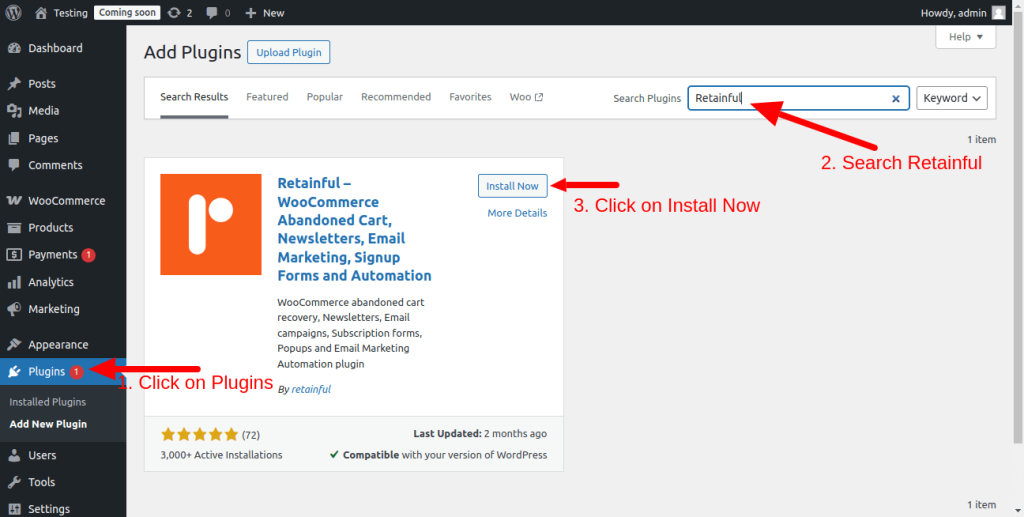
Click “Install Now” to install and activate it. Once you have installed Retainful, connect your online store.
E-commerce stores using Retainful are recovering an average of 30% of abandoned carts. Yours could be next.
Step 2: Select the Automation Workflow (Order Confirmation Email)
Retainful offers many automation workflows like welcome email series, order follow-up emails, and more.
To edit the email template, in your Retainful dashboard -> Automation -> Create Workflow.
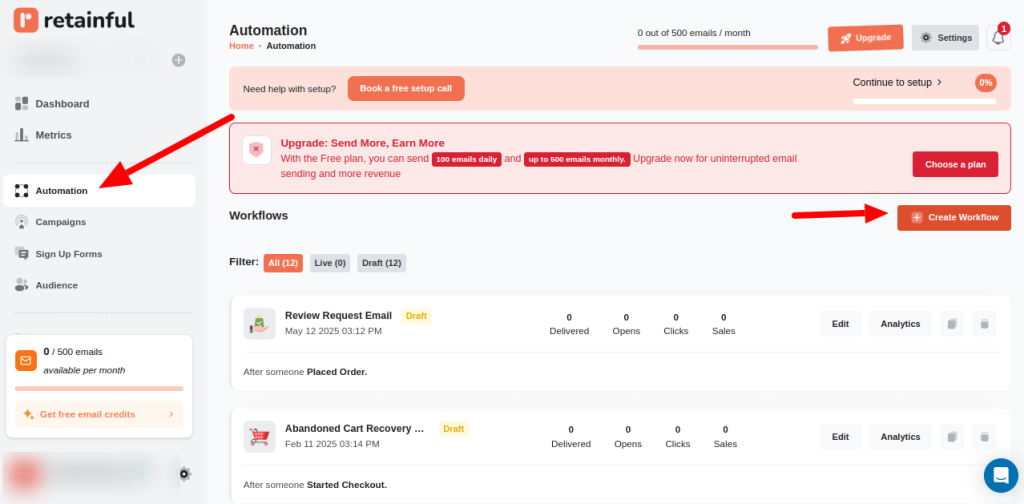
Select the type of automated email. For this example, we will take a look at the order confirmation email series.
Select the “Order Confirmation With Next Order Coupon” workflow.

Step 3: Edit Subject Line and Preview Text
In the Automation workflow, there will be triggers, a wait block, a coupon block, and an email block.
To edit the email template, select the email block. A tab will appear on the right side. Here you can edit your email’s subject line and preview text.
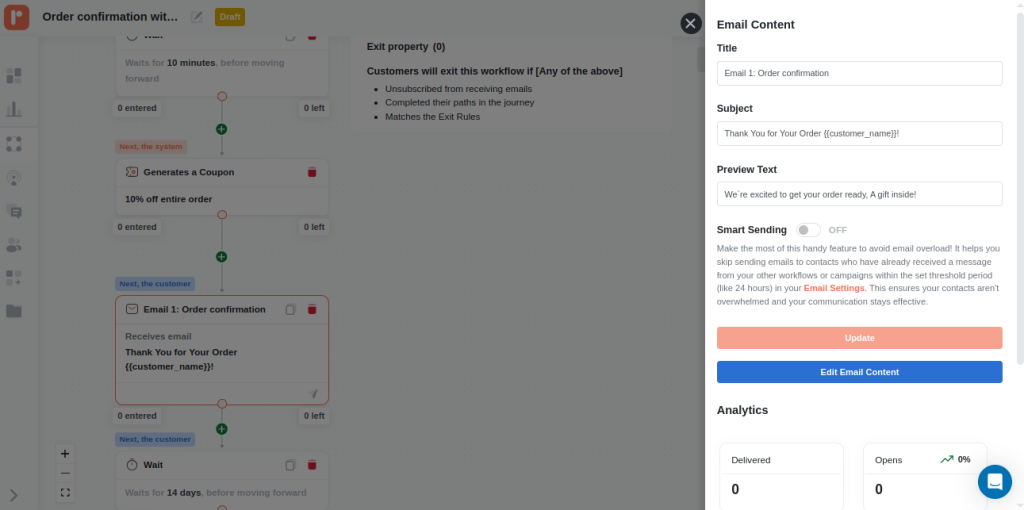
For further customizations like email design, content, visuals, and CTAs, click the “Edit Email Content” to open the template in the email editor.
Step 4: Customize Your Email Template
Inside the email editor, you can customize your email completely — drag and drop the elements where you want them.
The blocks in the Content section will let you add headers, footers, buttons, images, GIFs, and social media icons.
Moreover, from the Store Content section, you can add dynamic coupons, review sections, and order summary sections.
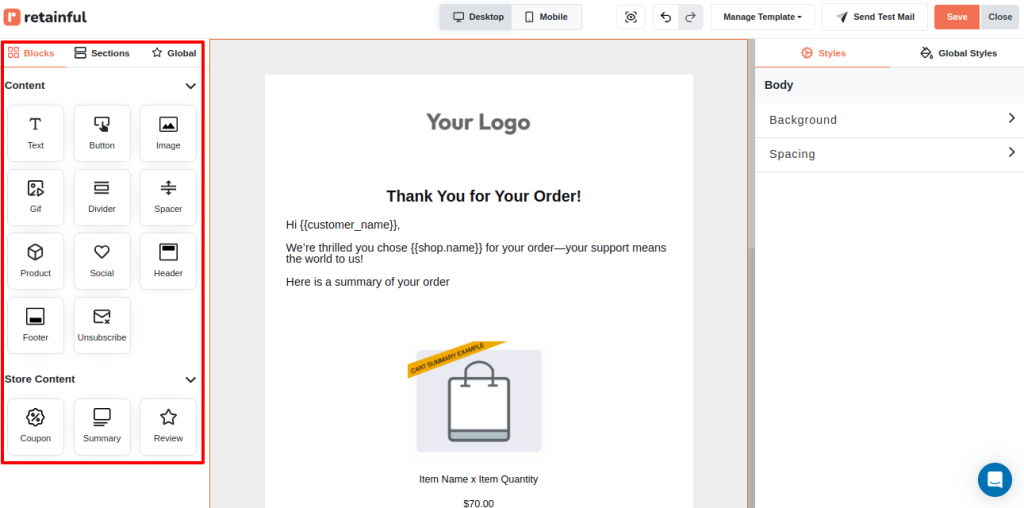
To edit any block in your email, simply click on it.
Once you do, a customization panel will appear on the right side of the screen.
From there, you can tweak the style settings — like adjusting the size, changing the colors, updating the padding, and more.
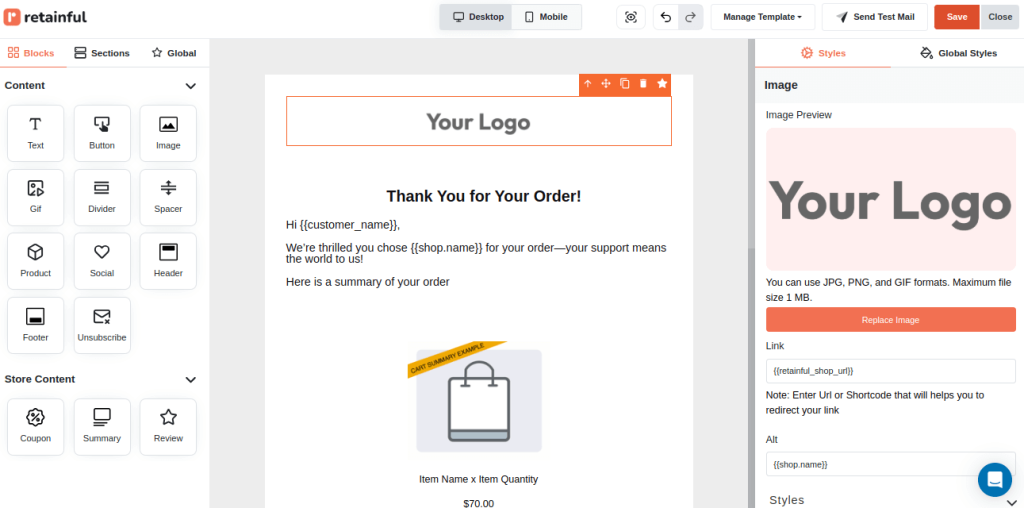
Step 5: Preview and Send Test Mail
You can preview how your email is rendering on mobile and desktop.
As a final step, you can even send yourself a test email to check how your email looks in your subscriber’s inbox.
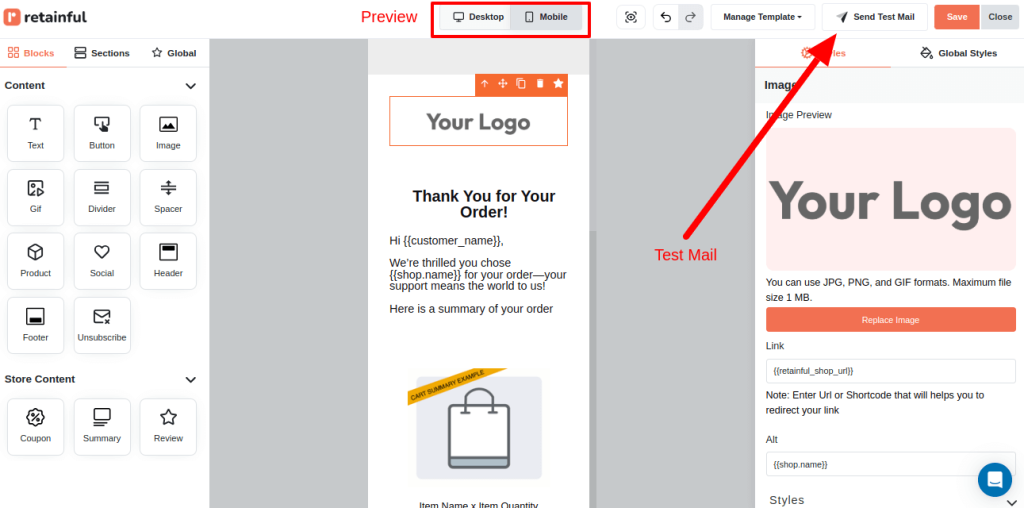
Top 5 WordPress Email Customizer Plugins
Plugins make any work much easier and time-saving. Editing WordPress email templates is no exception to this rule. However, finding the best plugin to do the job is quite difficult with hundreds of plugins in the store.
Here are the 5 best email WordPress email customizer plugins:
1. Retainful
Retainful is the best WordPress email customizer plugin. It is ideal for ecommerce owners and marketers.
You can choose from hundreds of templates for every occasion— e-commerce transactional emails, abandoned cart recovery emails, Cyber Monday, Black Friday, and even email newsletters.
The best part, you can send personalized emails too with advanced email segmentation and dynamic content blocks.

Related Reading:
- 11 Best Ecommerce Email Templates + Examples for 2025
- 10 Best Discount Email Templates + Examples
2. Spark Editor
Another great no-code email customizer plugin is Spark Editor. It’s designed to be simple, yet powerful — perfect for anyone, even without coding skills.
With Spark Editor, you get an intuitive drag-and-drop editor that’s easy to use. In addition, it comes with a collection of responsive email templates that look great on both desktop and mobile.
Plus, you can enhance your emails further using shortcodes and handy add-ons.
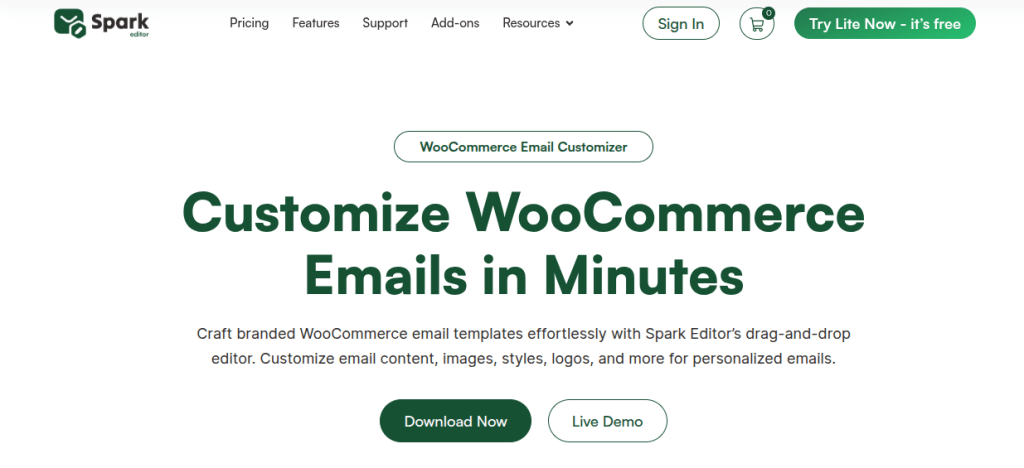
3. MailPoet
MailPoet is useful for bloggers and small business owners.
It comes packed with features like pre-built templates, list segmentation, and analytics.
Moreover, you also get MailPoet’s own built-in sending service, which means you don’t need to rely on third-party email tools.

4. Email Templates
If you want full control over how your WordPress and WooCommerce emails look, Email Templates is a solid pick.
This plugin makes it super easy to design and personalize your default email templates. You can give each email your unique brand touch.
One standout feature is the ability to import and export email designs, making it easy to reuse styles across projects. It also integrates well with plugins like Post SMTP.
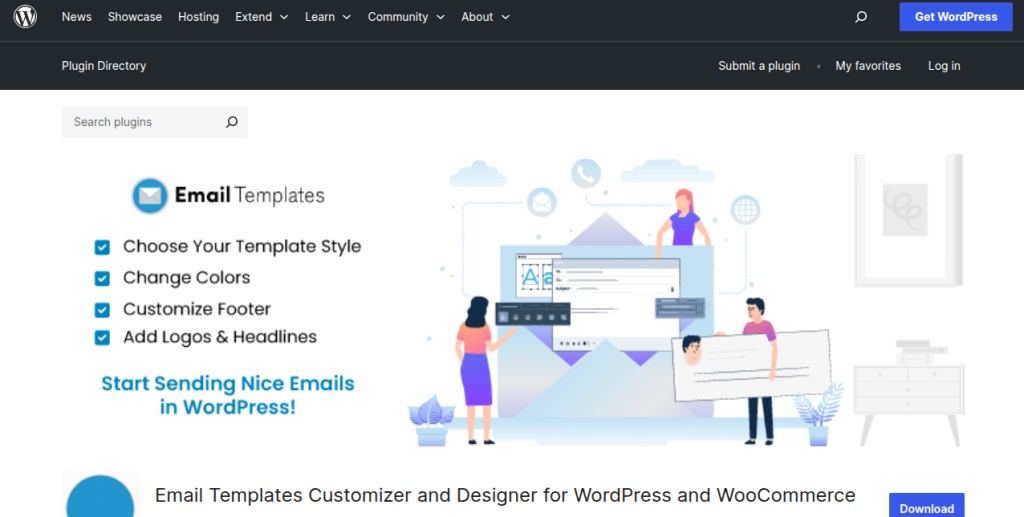
5. WP Email Template
If you're looking for a lightweight solution to send good-looking emails, WP Email Template is a good pick. It keeps things simple while giving you the essentials.
This plugin automatically wraps every email your site sends, including ones from plugins like WooCommerce, Contact Form 7, or Gravity Forms.
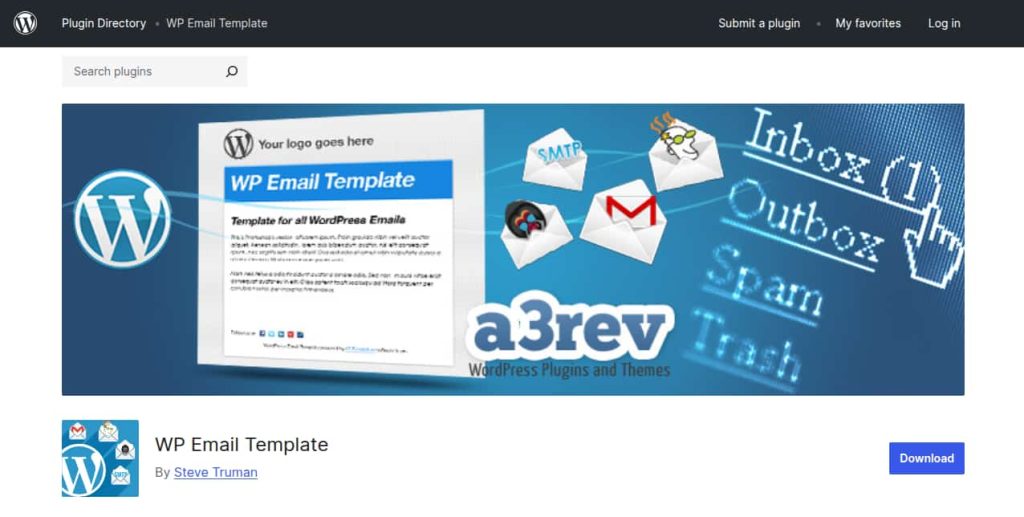
Customize ready-to-use email templates within minutes using Retainful to send a on-brand email at every touchpoint.
Wrapping Up!
The bottom line is that editing a WordPress email template is not that complicated. You can send stunning professional emails in WordPress without a single line of code using plugins.
If you are in e-commerce marketing, it’s best to stick to plugins like Retainful. This plugin is designed specifically for ecommerce needs.
It has an email for all the e-commerce scenarios - Discount emails, order follow-up emails, first purchase coupon, etc.
Plus, using a specialized tool saves you time and effort.
Also Read:
- How to send WooCommerce Newsletters (+ Plugins)
- 13-Point Email Marketing Checklist to Get 100% Results
- 19 Effective Email Marketing Strategies for 2025
Frequently Asked Questions
You can customize them using hooks and filters in your theme’s functions.php file since core WordPress email files shouldn’t be edited directly.
Yes, copy the email template files from WooCommerce’s plugin folder into your theme’s /woocommerce/emails/ folder and edit them safely.
Basic coding knowledge is recommended to edit templates directly, but you can use no-code plugins for easier customization.
Top options include Retainful, Spark Editor, and Spark Editor for drag-and-drop email design.
Create a /woocommerce/emails/ folder inside your active theme, then copy WooCommerce email files there and customize them.
Yes, most email customizer plugins like Retainful offer live preview and test email features to check your design before sending.
Core WordPress emails cover basic notifications like password resets, while WooCommerce handles order and customer-related ecommerce emails.
Yes, with plugins like Retainful or WooCommerce extensions, you can set up automated emails for abandoned carts and more.
